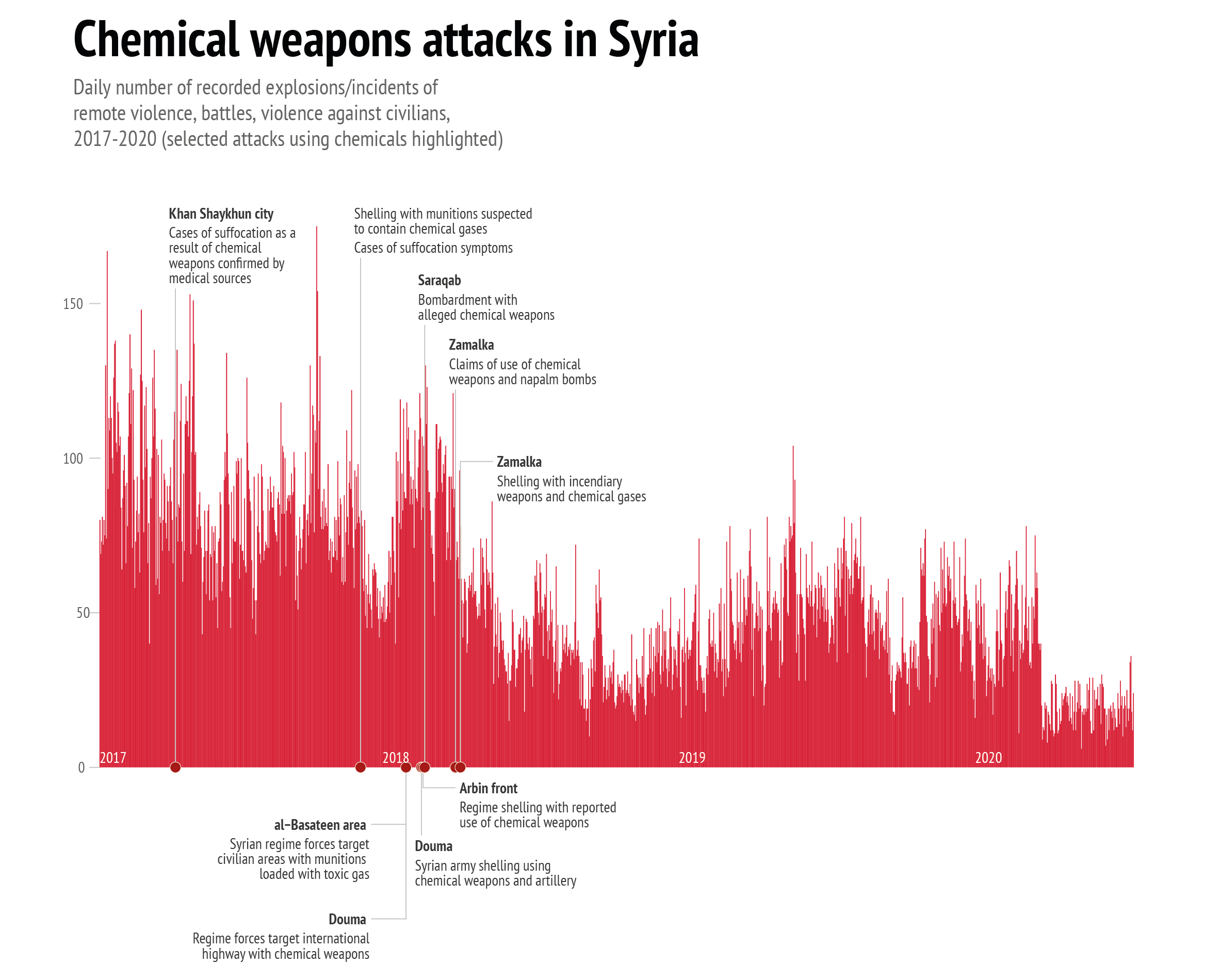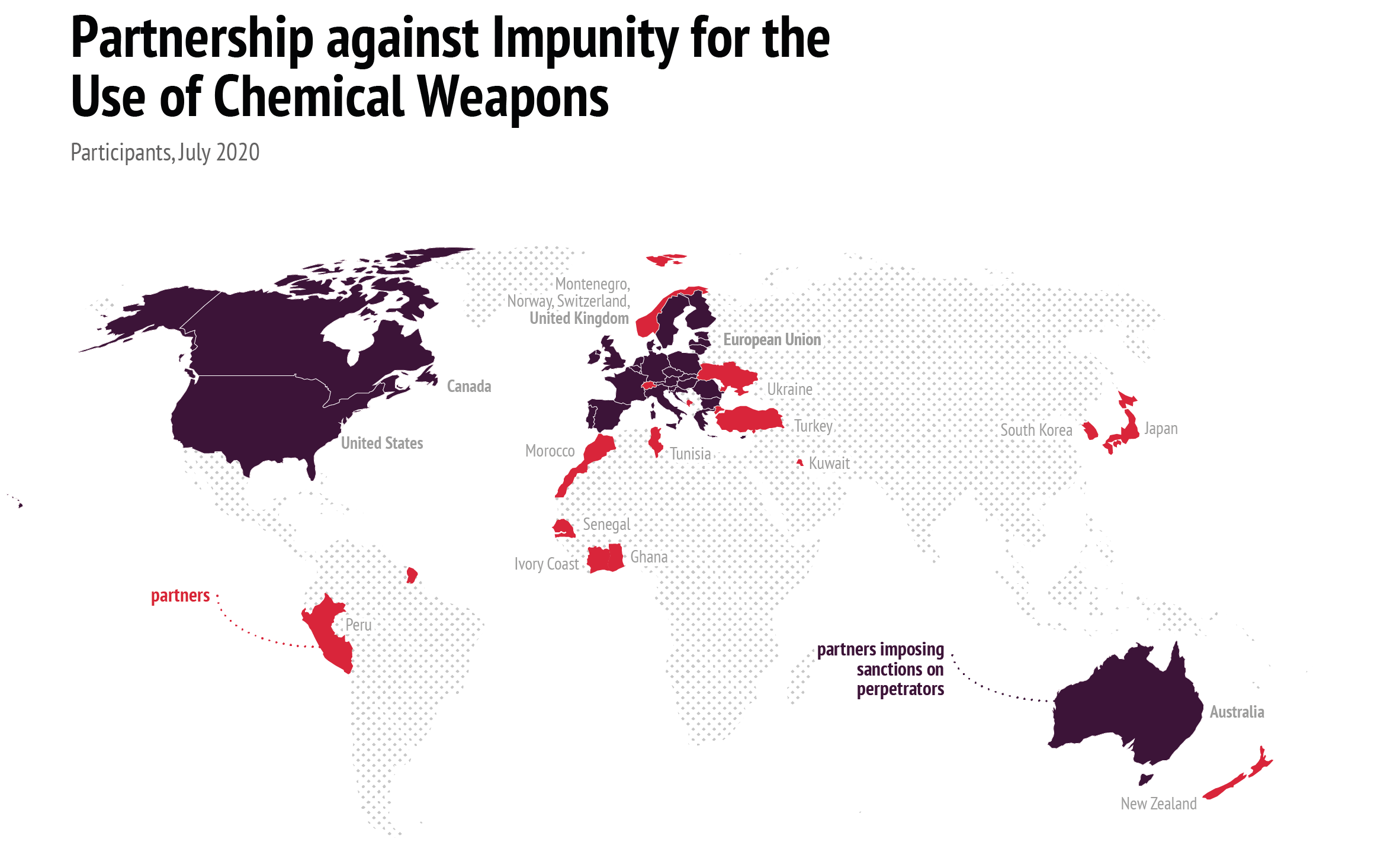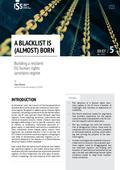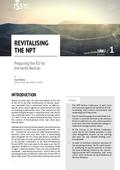You are here

The EU’s chemical weapons sanctions regime
Introduction
Marking a worrying turn for international policymakers, the use of chemical weapons has increased in recent years in spite of the robust disarmament regime seeking to curb their use. In October 2018, the EU adopted a sanctions regime against the proliferation and use of chemical weapons.1 The 2018 sanctions regime constitutes the EU’s first coercive instrument against chemical weapons. Even though the EU had previously employed sanctions to halt nuclear proliferation, in accordance with its 2003 Strategy against the proliferation of weapons of mass destruction (WMDs),2 it had never applied sanctions to chemical weapons activities. Also, previous EU non-proliferation sanctions had taken place against the background of a pre-existing mandate agreed by the United Nations Security Council (UNSC). Both Pyongyang and Tehran had been under UN sanctions before Brussels enacted its own restrictions. By contrast, the EU sanctions regime against chemical weapons is not based on a UNSC mandate. Finally, the sanctions regime takes the form of a ‘horizontal’ or thematic list, in contrast to classical sanctions regimes that address specific country crises. The chemical weapons sanctions regime was only the second thematic sanctions regime ever adopted by the EU after the UNSC-inspired 2001 terrorism list. It was the first in a series of EU autonomous horizontal regimes adopted in close sequence: a sanctions regime against cyberattacks was agreed in 2019, and another against human rights violations is currently under preparation.3
The sanctions regime against chemical weapons is also exceptional in that it originated in the European Council, rather than in a working group of the Council of the European Union.4 When the sanctions regime was first adopted, it was accompanied by a blacklist addressing two vastly different uses of chemical weapons: it combined three individuals and one entity involved in chemical attacks on civilians in the Syrian war with the two suspects in the assassination attempt on a former Russian military intelligence officer and his daughter in Salisbury in the United Kingdom.5 A second round of designations in January 2019 followed a similar pattern.6 What accounts for this unusual combination of targets? What compelled the EU to agree on this novel form of sanctions regime? And what objectives is the EU pursuing with it?
The present Brief situates the EU sanctions regime in the context of the recent attacks in Syria and the UK and international efforts employed to limit the proliferation and use of chemical arsenals. It then explores why sanctions are emerging as a supplementary policy tool in tackling this shifting security challenge. A fourth section analyses the implications for the EU’s Common Foreign and Security Policy (CFSP), before the final section concludes with recommendations for further action.
The taboo against chemical attacks
The Chemical Weapons Convention (CWC) of 1993 places a global prohibition on the production, stockpiling and use of all toxic chemicals and their precursors. A toxic chemical is ‘[a]ny chemical which through its chemical action on life processes can cause death, temporary incapacitation or permanent harm to humans or animals’.7 Chemical weapons exist in a variety of forms, including gas, liquid and solid, and, along with nuclear, biological and radiological weapons, they are considered to be WMDs on account of their potentially indiscriminate reach.
The CWC governs one of the most robust disarmament regimes in history.
While chemical weapons were employed to devastating effect in the past century, notably in the two World Wars, the Vietnam War and the First Gulf War, over the past few decades they have become increasingly rare in military arsenals.8 The CWC governs one of the most robust disarmament regimes in history. Its membership, consisting of 193 states representing over 98% of the world population, makes the CWC quasi-universal. Only Egypt, North Korea and South Sudan remain outside the treaty, while Israel is a signatory that has not ratified it. The Hague-based Organisation for the Prohibition of Chemical Weapons (OPCW), the implementing body of the CWC and winner of the Nobel Peace Prize in 2013, is charged with verifiably eliminating chemical military stockpiles, preventing their re-emergence and promoting peaceful uses of chemistry. State parties are under a legal obligation to submit annual declarations and destroy their remaining stockpiles under the monitoring responsibility of the OPCW. Eight states declared possession of chemical arsenals upon joining the CWC, including Russia and the United States, which acceded in 1997, and Syria, its most recent member. Certain states failed to meet the original deadline set for 2007 due to the difficulty and expense of destruction. Washington reported the destruction of 90% of its stockpile and plans to abolish it completely by 2023, while Moscow reported the complete destruction of its 39 967 metric tonnes of chemical weapons in 2017.9 Nevertheless, the repeated and recent use of such weapons in Syria, and more recently the UK, marks a pressing new security challenge, raising concerns about the erosion of the taboo on chemical weapons use. Also, the use of Novichok, a nerve agent originally of Soviet manufacture, casts doubts on the elimination of Russia’s chemical arsenal.
Breaking the taboo in Syria
Chemical weapons have been used against civilians in the Syrian civil war since 2012, although the exact number of attacks is disputed, with estimates ranging from 40 to 336.10 The first major incident involved a sarin attack in the opposition-controlled Damascus suburb of East Ghouta in August 2013, which is believed to have resulted in more than 1,000 casualties. At this time, military action was contemplated, but eventually ruled out by the US, which had warned the Syrian leadership that the use of chemical weapons would ‘cross a red line’, an assessment shared by its allies France and the UK.11 Instead, this episode compelled Russia and the US to pressure Syria to accede to the CWC, which led to the elimination of the overwhelming majority of its arsenal of around 1,300 tonnes of chemical warfare agents.12 Since chemical attacks continued in Syria, the OPCW set up a fact-finding mission (FFM) in 2014 to conduct investigations into the incidents. After investigating more than 80 allegations, the FFM reported that chlorine, sulphur mustard and sarin had been used in the Syrian civil war at least 38 times.13 However, it was not mandated to attribute responsibility for the attacks it confirmed. To remedy this shortcoming, the UNSC established, in cooperation with the OPCW, a joint investigative mechanism (JIM) in 2015 to identify the perpetrators of attacks confirmed by the FFM.14 Of the 11 cases it investigated in its less than 2 years of operation, JIM attributed two sulphur mustard attacks to the designated terrorist group ISIS and three chlorine attacks to the Syrian army.15
After responsibility was attributed to the Syrian armed forces for the sarin attack of April 2017 in the north-western town of Khan Shaykhun – the largest incident since the 2013 Ghouta episode – Russia vetoed the extension of JIM’s mandate at the UNSC in November 2017. Chemical weapons usage continued in April 2018, notably in the form of a chlorine attack on the Syrian city of Douma. The US reacted to the attack in Khan Shaykhun with airstrikes against a Syrian airfield, and following the Douma incident it bombed facilities connected with the Syrian chemical weapons programme jointly with France and the UK. In March 2017, draft resolutions were tabled at the UNSC either decrying Syria’s use of toxic agents or condemning the Western allies’ airstrikes in Syria; however, none of them were adopted, in light of the polarisation among the P5 members.16 Similarly, the following year, three draft resolutions tabled by Russia and the US detailing an accountability mechanism failed to pass, confirming that the UNSC had lost its ability to deal with chemical weapons use in Syria.17
After the demise of JIM in late 2017, action shifted to The Hague. The UK requested a special session of the CWC Conference of State Parties, where it proposed that the OPCW’s mandate be expanded to enable the identification of perpetrators of chemical attacks. The proposal was approved as it achieved the required two-thirds majority, but proved divisive, with 84 positive votes, 24 negative votes and 26 abstentions. Moreover, it broke with the tradition of consensus decision-making at the OPCW. In the words of an expert, ‘never before had such a radical change to OPCW procedures been decided by a majority vote’.18 The new mandate tasked the OPCW Secretariat with the identification of those responsible for chemical weapons attacks in Syria, and stipulated that ‘whenever a chemical weapons use occurs on the territory of a state party, perpetrators or actors otherwise involved should be identified’. By transferring responsibility for attribution from the UNSC to the OPCW, the threat of a P5 veto could be successfully circumvented. The Investigation and Identification Team, created by the OPCW in the implementation of its expanded mandate and operational since May 2019,19 identified the Syrian air force as being responsible for chemical attacks in and around the central Syrian town of Ltamenah in March 2017.
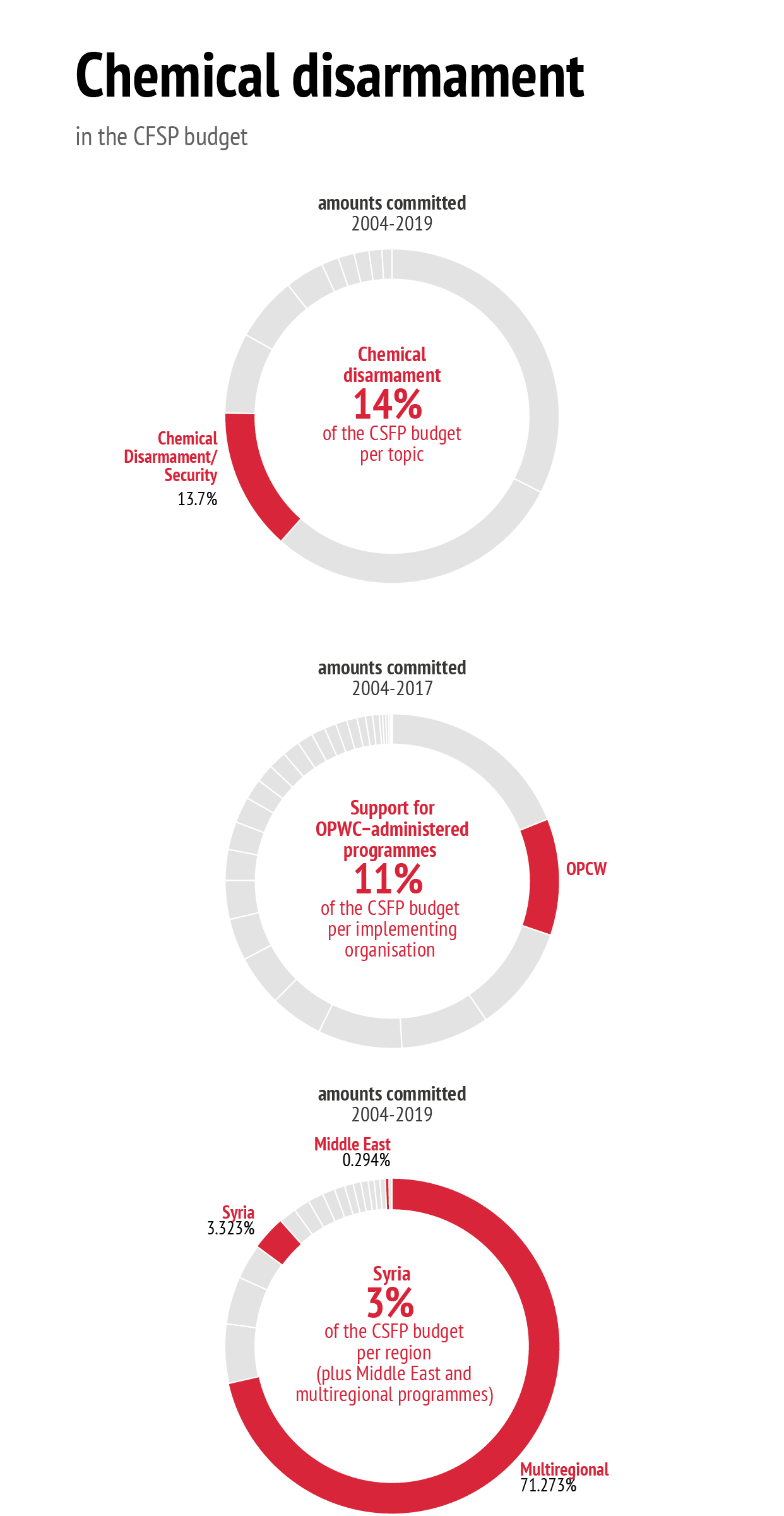
Data: EEAS, 2020
In parallel to these efforts, in January 2018, the French government launched the International Partnership against Impunity for the Use of Chemical Weapons (the ‘Partnership’), bringing together a coalition of 40 states and an international organisation, the EU, seeking to supplement international mechanisms to combat the surge in chemical weapons usage.20 While only 10 of the 14 original members were EU member states, the rest joined in the following 2 years. Cross-regional support was enlisted thanks to the participation of Japan, Kuwait, Morocco, Peru, Senegal, South Korea and Turkey, among others. Its Declaration of Principles identifies the continuing use of chemical weapons as a threat to the international peace and security architecture, and pledges to hold accountable those who are responsible. Members of the Partnership pledge to compile and share information to support accountability efforts, prosecute individuals and support common positions in relevant fora. The Partnership entails a sanctions component in that its members commit to ‘publicis[ing] the names of individuals, entities, groups or governments placed under sanctions for their involvement in the proliferation or use of chemical weapons through a dedicated website’.
Data: ACLED, 2020
Breaking the taboo in Salisbury
In March 2018, an attempted assassination of former Russian intelligence officer Sergei Skripal and his daughter was carried out in Salisbury, using a Novichok nerve agent. The attack was attributed to Moscow by the UK government and the OPCW.21 The use of chemical weapons on British soil triggered immediate action by London, resulting in the suspension of high-level bilateral contacts with Moscow, the freezing of Russian state assets and increased checks on private flights, customs and freight. Jointly with Canada, France, Germany and the US, the UK authorities identified the suspects as officers from the Russian military intelligence service and effected what they claimed to be the ‘largest ever collective expulsion of undeclared intelligence officers’, ultimately leading to the withdrawal of credentials of over 150 Russian diplomats from Western states, 23 of whom were expelled from the UK.22 At London’s request, a majority of EU member states expelled smaller numbers of Russian diplomats.23 The EU called on Russia to provide ‘complete disclosure of its Novichok programme to the OPCW’, expressing ‘unqualified solidarity with the UK’.24 The location of the attack on the territory of what was still a member state at the time contributed to the speed and intensity of the EU’s reaction.25 The fact that this show of support occurred during the period of the negotiations over the UK’s withdrawal from the bloc after almost six decades of membership further heightened its symbolic weight.
The international reaction to the Salisbury poisoning attempt was not limited to the expulsion of diplomats. Washington’s response was the most resolute. The US already had sanctions in place under the Chemical and Biological Weapons Control and Warfare Elimination Act of 1991 to address chemical weapons use in Syria since 2013, and against North Korea following the nerve agent assassination of its leader’s relative, Kim Jong-nam, in Kuala Lumpur in February 2017. Following the Salisbury incident, the US designated several Russian elite members and entities citing Russian engagement ‘in a range of malign activity around the globe’. It also restricted exports with military applications and Russian access to US financial services, threatening additional measures unless Moscow provided assurances that it would not use chemical weapons again.26 Claiming that such assurances had not been issued, in August 2019 US banks were prohibited from granting loans or credit to Russia, and Washington adopted a policy of opposing assistance to Russia by international financial institutions.27 Australia and Canada also enacted various sanctions measures in response to the use of chemical weapons in Malaysia, Syria and the UK, blacklisting especially individuals and entities linked to the Syrian government’s chemical weapons programme.28 Further afield, however, support was less forthcoming. Japan opted not to condemn the Salisbury incident, while New Zealand refused the UK’s request to expel Russian diplomats, seemingly driven by a desire to avoid derailing relations with Moscow.29 Elsewhere, non-Western powers remain reluctant to enact sanctions in the absence of a UN mandate, despite their support for the chemical disarmament regime.30
The EU and the unfinished edifice of accountability
Against this backdrop, the European Council gave instructions for the development of a dedicated chemical weapons sanctions regime. By then, the EU had already designated certain actors for the use of chemical weapons as part of its autonomous sanctions regime in Syria. Brussels formally added chemical weapons usage to the designation criteria in 2015 and, pledging to uphold international humanitarian law, included the fight against the use of chemical weapons in its Syria strategy of 2017.31 Scientists and military officers were designated based on the conclusions of JIM. Although the text of the EU sanctions regime does not make explicit reference to the Partnership, reading it in conjunction with the Partnership’s Declaration of Principles helps to clarify the rationale of the sanctions. A first objective is, plainly, to oppose the erosion of the norm against chemical attacks, which remains strong – in spite of recent developments – since no state has contested its validity or its own adherence to it. As such, the imposition of sanctions on individuals involved aims to uphold the norm by imposing costs on perpetrators and accomplices, freezing their assets to disrupt their activities and widely publicising their identities in a ‘naming and shaming’ exercise.
Data: GPPI, 2019
Sanctions listings are complementary to the work performed by relevant bodies like the OPCW. As its Director-General Fernando Arias points out, ‘attribution is not accountability’. Once the blame has been assigned to specific actors, enforcement measures are in the hands of others. The emphasis of the initiative, dubbed ‘fighting impunity’, is on promoting accountability.32 For the time being though, accountability mechanisms are unavailable. Nevertheless, the sanctions regimes enacted by the EU and its partners can prepare the ground for the activation of full-fledged accountability mechanisms such as at the International Criminal Court (ICC). While chemical attacks in Syria qualify as war crimes, the ICC lacks jurisdiction as Damascus has not signed its statute. However, its jurisdiction could, in theory, be activated at some future date through a referral by the UNSC or via Syria’s accession under a different leadership in the future. With this possibility in mind, the Partnership foresees the preservation and sharing of information to support international efforts ‘so that those responsible may one day be brought to justice’.33 This alludes to the work of the International and Independent Commission of Inquiry, a body set up by the UN Human Rights Council in 2011 to investigate human rights violations in Syria, including chemical attacks. Finally, by indicating that individuals found to be implicated in any chemical attack might face arrest and prosecution, the sanctions regime is expected to deter further use.
Implications for EU foreign policy
The adoption of the sanctions regime against chemical weapons has implications for three key areas of the CFSP: non-proliferation policy, support for multilateralism and EU–Russia relations. Firstly, EU non-proliferation policies are taking an increasingly coercive tone. The EU had reserved the option of imposing sanctions ever since the official launch of its 2003 Strategy against Proliferation; however, it emphasised non-coercive tools, both in rhetoric and in action. Its activities consisted of cooperative threat reduction – most prominently in funding the destruction of the vast chemical arsenal Russia inherited from the Soviet era – and the support of OPCW activities. This started to change with the adoption of additional bans and designations to reinforce UN measures on Iranian and North Korean targets over the past decade.34 With the EU’s new thematic sanctions regime, coercive measures now extend to the chemical weapons domain. Underlining its exceptional character, the coalition under the Partnership does not operate under the aegis of the UN. Also, the EU strategy originally dealt with the use of chemical weapons as WMDs only. With the adoption of the sanctions regime, EU action now addresses all forbidden uses of chemical weapons, including in targeted killings.
Secondly, current efforts in upholding the prohibition against chemical weapons use are, while imperfect, the solution that comes closest to a multilateral endeavour. Consequently, EU action makes up for the shortcomings of the international chemical disarmament regime. In the face of difficulties articulating a response via the UN’s multilateral framework, the EU is taking part in the largest possible multinational effort, including its major allies, to increase pressure on the individuals and entries involved. As a compromise between targeted bombings and political declarations, sanctions by a coalition constitute a middle ground between the unilateralism of individual action of questionable legality and the multilateralism of the quasi-universal UN and OPCW. As a former US official noted, unilateral strikes such as those that followed the Khan Shaykhun incident give the impression that chemical weapons usage is of concern to the US only, rather than to the global community.35 Perversely, because the bombings in retaliation for the Khan Shaykhun and Douma attacks occurred before the FFM had reported any findings, they rendered its investigations superfluous, eliciting allegations that the attacks had been perpetrated or fabricated by rebel forces.36
Thirdly, and most importantly, the EU’s chemical weapons sanctions regime is as much about chemical attacks as it is about managing relations with Russia. Indeed, it represents an attempt to adopt targeted restrictions against Russian and Syrian individuals without altering the politically loaded sanctions regimes on these countries. In this regard, the EU is increasingly breaking ranks with the US in its approach to sanctions towards Moscow. Washington’s Countering America’s Adversaries through Sanctions Act of 2017 consolidates into a single law concerns that were previously handled separately, including the Ukraine crisis, cyberattacks, subversion, corruption, human rights violations and breaches of arms control agreements such as the Intermediate-Range Nuclear Forces Treaty and the Open Skies Treaty.37 By clustering different motivations into the same piece of legislation, Washington is making the lifting of such measures considerably more difficult.38 Taking the opposite approach, since 2014 Brussels has been putting in place a composite, ‘demountable’ sanctions regime – where separate sanctions can be lifted independently of one another – to address the Ukraine crisis.39 Three different EU sanctions packages address distinct aspects. One sanctions regime refers to the destabilisation of eastern Ukraine, a second tackles the annexation of Crimea and a third addresses the misappropriation of Ukrainian state funds. The establishment of a separate, horizontal sanctions regime to target Russian individuals and entities involved in chemical weapons abuses reflects a reticence to further escalate the existing sanctions package on Moscow. Listing Russian targets on multinational blacklists allows Brussels to address these breaches without assigning blame directly to the Kremlin. This allows for the bridging of persisting divisions among those EU member states favourable to the stepping-up of existing measures and those opposed to it, maintaining EU unity despite conflicting viewpoints.40 Finally, the adoption of a sanctions regime in a horizontal format, which is standard in North America and the UK, facilitates the future transfer of listings between Brussels and its partners after London’s withdrawal from EU structures.
Data: noimpunitychemicalweapons.org, 2020; Natural Earth, 2020
Conclusions and recommendations
The creation of a horizontal sanctions regime on chemical weapons represents the culmination of a process in which the EU endeavoured to uphold the prohibition of chemical weapons attacks in the face of blatant violations in the Syrian civil war. In a first phase, it gave preference to the UNSC–OPCW handling of the breaches, which fructified in the joint establishment of JIM. Only after the collapse of JIM in late 2017, and in the face of the polarised entrenchment at the UNSC, did EU action outside multilateral frameworks emerge. The first months of 2018 brought a turning point. The French government launched a Partnership against Impunity in January 2018 alongside a handful of member states, and soon all of them coalesced behind it. The Salisbury attack of March 2018 compelled the UK to mount a large-scale diplomatic protest. As the second targeted chemical poisoning on European soil this century, after the assassination with polonium of Alexander Litvinenko in London in 2006, it laid bare Europe’s vulnerability to chemical weapons abuses.41 In EU capitals, upholding the prohibition of chemical weapons became less about promoting respect for the CWC globally and more about protecting Europe from further toxic attacks. The French and British leaderships combined to uphold the taboo against chemical attacks, and soon attracted the support of EU partners, crystallising in the adoption of a dedicated sanctions regime at the EU level. However, the EU only articulated a response outside global organisations after multilateral avenues had been exhausted and had proved of little avail.
The Salisbury attack of March 2018, after the assassination of Alexander Litvinenko in London in 2006, laid bare Europe’s vulnerability to chemical weapons abuses.
Although the EU chemical weapons sanctions regime is in its infancy, one area shows room for improvement: the harmonisation of the listings. There seems to be an imbalance in listing almost as many entries for involvement in a single assassination plot in Salisbury as for the conduct of dozens of attacks that resulted in hundreds – if not thousands - of civilian casualties in Syria. The first led to the designation of four individuals, while the second resulted in the listing of five individuals and one laboratory. However, this imbalance is only apparent because designations feature on two separate lists. Both the Syria sanctions regime and the one focused on chemical weapons include involvement in chemical attacks as a designation criterion. As a result, some – but not all – actors implicated in chemical weapons use in Syria feature on both lists. As such, and contrary to what the chemical weapons sanctions blacklist might suggest, there are not just 10, but approximately 30 EU designations for chemical weapons usage.
Multiple listings, which see individuals designated under two different sanctions regimes for the same wrongdoing, are not unusual: the US has listed Iran’s Islamic Revolutionary Guards under seven sanctions authorities.42 However, they ought to be avoided. In the EU, duplicate listings result from the co-existence of country-specific and horizontal sanctions regimes. This practice creates confusion for private and public sector stakeholders in the EU and beyond that are seeking to work with, or in, Syria – including medical and food companies, humanitarian organisations and the banks servicing their activities. This adds to the difficulties faced by those seeking to navigate the already complex compliance environment. Multiple designations should be reserved for cases in which one actor is designated for different wrongdoings. The same actor may, for example, be responsible for misappropriating state assets and spoiling a peace process. The logical consequence of double listing is that redressing each wrongdoing is associated with the removal of that actor from the corresponding list.43 In this case, however, naming the same actor in two separate lists for the same wrongdoing causes confusion as to how many perpetrators of chemical attacks are listed. Transferring all actors involved in chemical weapons usage in Syria to the new horizontal regime would expose the number and the identities of perpetrators more visibly.
References
1 Council Decision (CFSP) 2018/1544 concerning restrictive measures against the proliferation and use of chemical weapons, October 15, 2018.
2 Council of the EU, “EU strategy against the proliferation of weapons of mass destruction”, December 2003, https://eeas.europa.eu/sites/eeas/files/st_15708_2003_init_en.pdf
3 See Erica Moret and Patryk Pawlak, “The EU cyber diplomacy toolbox: towards a cyber-sanctions regime?”, EUISS Brief, no. 24, May 2017, and Clara Portela, “A blacklist is born: building a resilient EU human rights sanctions regime”, EUISS Brief, no. 5, March 2020.
4 Conclusions of the European Council, June 28, 2018; Viktor Szép, “New intergovernmentalism meets EU sanctions policy”, Journal of European Integration, 2019.
5 Caitriona McLeish, “The Skripal case”, SIPRI Yearbook 2019 (Stockholm: SIPRI, 2019), pp. 408-417.
6 See official website EU Sanctions Map, https://www.sanctionsmap.eu/#/main/details/46/?search=%7B%22value%22:%22%22,%22searchType%22:%7B%7D%7D
7 Convention on the Prohibition of the Development, Production, Stockpiling and Use of Chemical Weapons and on their Destruction. Its definition of chemical weapons includes munitions or devices designed to inflict harm or cause death and any equipment designed for use directly in connection with their employment.
8 Jean-Pascal Zanders, “Preventing the re-emergence of chemical weapons”, EUISS Brief, no. 3, April 2019.
9 John Hart, “Celebrating a milestone: Russia completes the destruction of chemical weapons stockpile”, SIPRI Experts Comments, September 2017.
10 Una Becker-Jakob, “Countering the use of chemical weapons in Syria: options for supporting international norms and institutions”, Non-Proliferation and Disarmament Papers, no. 63, SIPRI, 2019.
11 John Hart, “Chemical and biological weapon programmes”, SIPRI Yearbook 2014 (Stockholm: SIPRI, 2014), pp. 389-402.
12 Oliver Meier, “Chemical weapons attacks: the end of anonymity”, SWP Comments, no. 32, June 2018.
13 OPCW, “OPCW issues fact-finding mission report on chemical weapons use allegation in Douma, Syria, in 2018”, March 2019.
14 UN Security Resolution, 2235, S/Res/2235, August 7, 2015, https://undocs.org/S/RES/2235(2015).
15 Op. cit., “Countering the use of chemical weapons in Syria”.
16 Dulcie Leimbach, “Confronting possible gas attacks in Syria, the UN Security Council succumbs to chaos”, Pass Blue, April 13, 2018.
17 Caitriona McLeish, “Allegations of use of chemical weapons in Syria”, SIPRI Yearbook 2019 (Stockholm: SIPRI, 2019), pp. 399-407.
18 Op. cit., “The end of anonymity”.
19 Johannes Visser, “A new OPCW team is ready to find the culprits behind chemical attacks in Syria”, Pass Blue, May 6, 2019.
20 Ministry of Foreign Affairs of France, “International Partnership against Impunity for the Use of Chemical Weapons: Declaration of Principles”, January 23, 2018. See official website, https://www.noimpunitychemicalweapons.org/-en-.html.
21 Op. cit., “The Skripal case”.
22 UK Foreign and Commonwealth Office, “Joint statement by the leaders of France, Germany, the US, Canada and the UK on the Salisbury attack”, Press release, September 6, 2018; Op. cit., “The end of anonymity”.
23 Julian Borger, Patrick Wintour and Heather Stewart, “Western allies expel scores of Russian diplomats over Skripal attack”, The Guardian, March 27, 2018.
24 Council of the EU, “Statement on the Salisbury attack”, Press 145/18, March 19, 2018.
25 Maxine David and Tatiana Romanova, “The EU in Russia’s house of mirrors”, Journal of Common Market Studies, vol. 57, no. S1, 2019, pp. 128-140.
26 US Department of the Treasury, “Treasury designates Russian oligarchs, officials, and entities in response to worldwide malign activity”, Press release, April 6, 2018; White & Case, “United States imposes sanctions related to Russia’s use of chemical weapons”, September 6, 2018.
27 “Skripal case: US slaps new sanctions on Russia”, BBC News, August 2, 2019.
28 Government of Canada, “Canadian sanctions related to Syria”, https://www.international.gc.ca/world-monde/international_relations-relations_internationales/sanctions/syria-syrie.aspx?lang=eng; Kathleen Harris, “Canada to expel 4 Russian diplomats, reject credentials of 3 more”, CBC News, March 26, 2018; Australian Department of Foreign Affairs and Trade, “Chemical weapons”, 2020, https://dfat.gov.au/international-relations/security/non-proliferation-disarmament-arms-control/chemical-weapons/Pages/chemical-weapons.aspx.
29 Maria Shagina, “Asia-Pacific responses to the Ukraine crisis”, Afers Internacionals, no. 125, forthcoming, 2020.
30 Rishika Chauhan, “Economic sanctions and chemical-biological weapons,” CBW Magazine, vol. 11, no. 2, 2018.
31 Council Decision (CFSP) 2015/1836, October 12, 2015; Council of the EU, “Council adopts EU strategy on Syria”, April 3, 2017, https://www.consilium.europa.eu/en/press/press-releases/2017/04/03/fac-conclusions-syria/
32 Alicia Sanders, “‘Everyone has a lot at stake’: a Q&A with Fernando Arias”, Arms Control Association, October 2018, https://www.armscontrol.org/act/2018-10/features/everyone-lot-stake-fernando-arias-opcw.
33 Op.cit., “Declaration of Principles."
34 Clara Portela, “The EU’s evolving responses to nuclear proliferation crises”, Non-Proliferation Papers, no. 46, SIPRI, 2015.
35 Rebecca Hersman, “Resisting impunity for chemical weapons attacks”, Survival, vol. 60, no. 2, 2018, pp. 73-90.
36 John Hart, “Allegations of use of chemical weapons in Syria”, SIPRI Yearbook 2018 (Stockholm, SIPRI, 2018), pp. 349-361.
37 Nigel Gould-Davies, “Russia, the West and sanctions”, Survival, vol. 62, no. 1, 2020, pp. 7-28.
38 Op. cit., “House of mirrors”.
39 Clara Portela, “The state of EU sanctions on Russia”, EUREN Brief, no. 1, 2019.
40 Op. cit., “EU sanctions on Russia”; Erica Moret and Maria Shagina, “The impact of EU-Russia tensions on the economy of the EU” in Lukasz Kulesa et al. (eds), Damage Assessment: EU-Russia Relations in Crisis, European Leadership Network, 2017.
41 Cindy Vestergaard, “Are chemical assassinations in vogue?”, Stimson Centre Commentary, March 2018.
42 James Givney, “Trump’s sanctions are losing their bite”, Bloomberg, 2 April 2020.
43 Op. cit., “A blacklist is (almost) born”.
